Today’s feature city guide from Asia covers some of top attractions worth considering while visiting in Macau, China including checking out Senado Square and the Ruins of Saint Paul’s Cathedral.
Top Attractions in Macau: Best 20 Things to do in Macao
Feeling well rested after going to bed several hours earlier than normal, we felt a jolt of adrenaline about exploring the historic areas of Macau located on another island from the hotel we were staying at.
Fortunately, our hotel offered ‘free’ transfer service from Cotai to the Macau Peninsula.
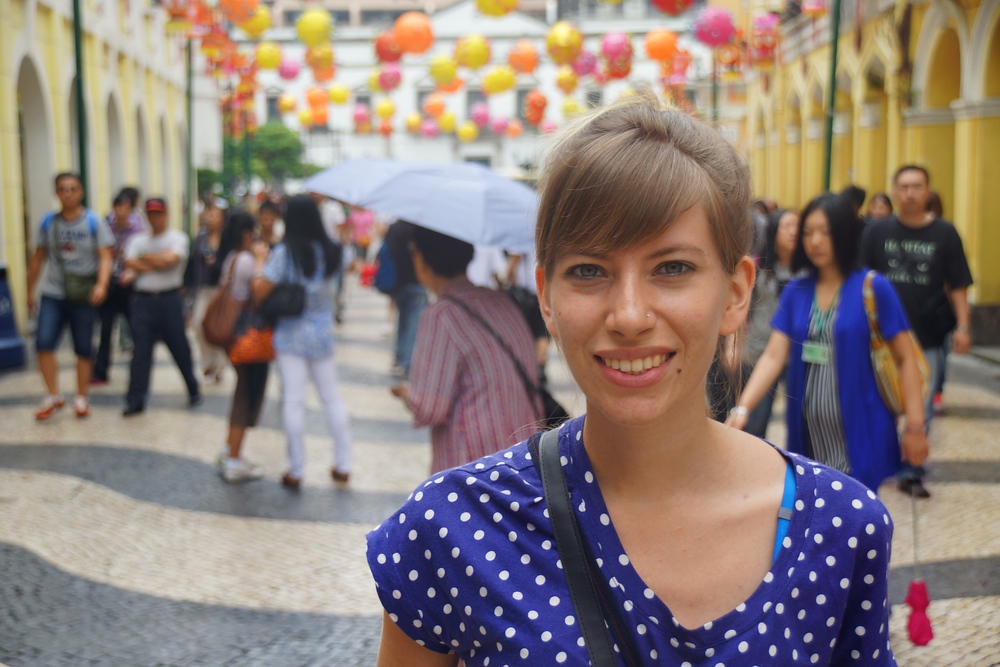
We literally went from an island filled with nothing but luxury casinos to a more historic area that featured historic Portuguese inspired architecture, cobbled walkways and a plethora of people.
As soon as we got outside of the transfer bus, Audrey marveled, “I feel as though I’m back visiting more relatives in Brazil or wandering around in Portugal.”

1) Senado Square
The first place we visited was the Senado Square (Portuguese: Largo do Senado; Chinese: 議事亭前地). With pastel colored buildings, Portuguese white & black pavement and a series of red lanterns, this place was a collision between East meets West.
Prior to Macau becoming the ‘Las Vegas’ of Asia with its plethora of casinos, Senate Square was the epicenter of the former Portuguese Colony of Macau.
As the Historic Centre of Macao (Chinese: 澳門歷史城區; Portuguese: O Centro Histórico de Macau) it is one of twenty locations featuring the melting pot of Chinese and Portuguese cultures in Macau.
As a street photographer this was the perfect location for me to people watch while snapping some candid portraits.
One thing we noticed almost immediately is that the signs in the city are written in both Chinese and Portuguese.
Even though Macau has been a Special Administrative Region of China since 1999, it has still retained its Portuguese influence from several centuries of colonial rule.
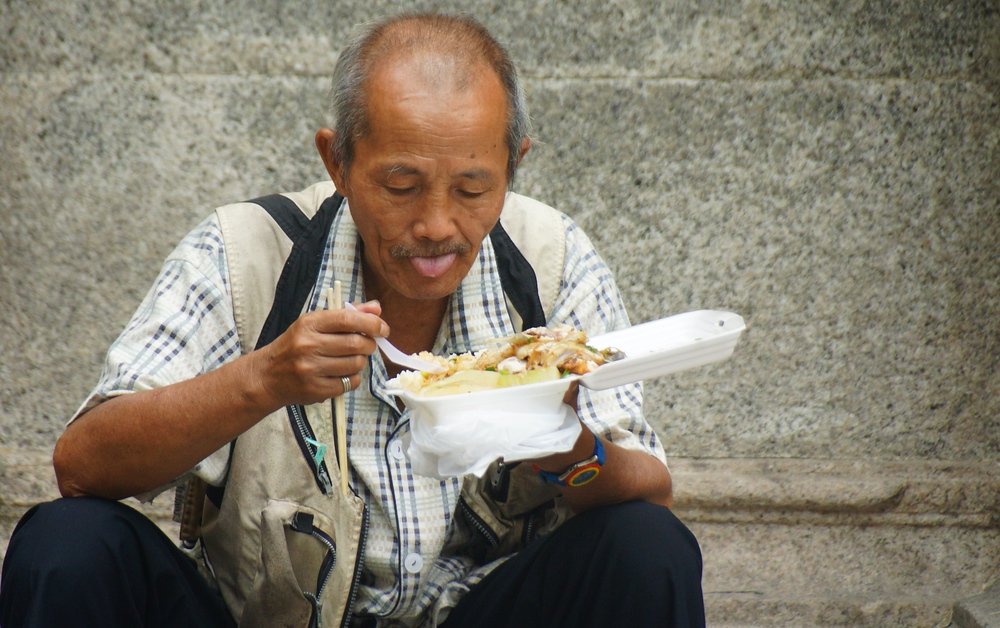
2) Macanese Cuisine
As we walked past the main square we started to branch off into a narrower alley where we were inundated by the exotic smells of Macanese delights being peddled by shop owners and hawkers alike.
Some of the most popular Macanese foods we sampled included Egg Tarts, Almond Cookies and Porkchops in buns.
Macanese cuisine is a mix of Portuguese, Chinese and SE Asian ingredients forming one of the more distinct fusion style cuisines in all of Asia.
After taking the time to gormandize on Macanese treats, we continued our ascent towards the imposing Ruins of Saint Paul’s Cathedral ((Portuguese: Ruínas de São Paulo, Chinese: 大三巴牌坊).
Considered as one of the most famous landmarks in all of Macau, these ruins are the place where most tourists pose to take a shot and/or purchase a postcard to send home.
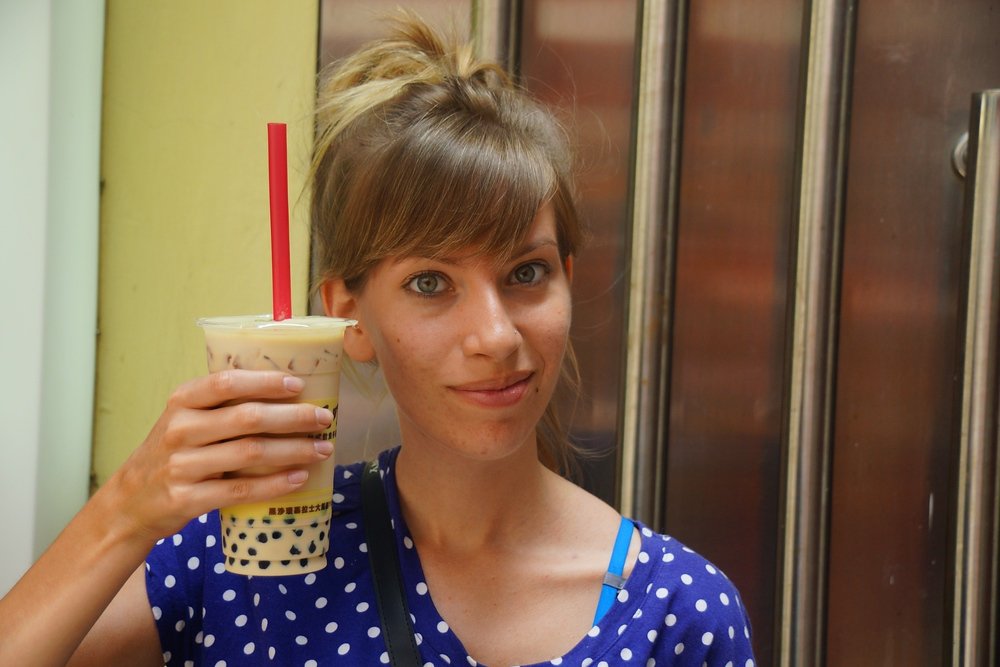
Before climbing the stairs to reach the top of the ruins, we first treated ourselves to a refreshing Pearl Milk Tea.
The heat and humidity of Macau in late August was on par with the weather we had been experiencing in SE Asia for several months.

3) Ruins Of Saint Paul’s Cathedral
This was distinctly different from the time I first visited back in February, 2008 when I could walk for kilometers on end without breaking a sweat.
Built from 1852 to 1602 by the Jesuits, Saint Paul’s Cathedral was one of the grandest churches in all of Asia.
Destroyed by a fire during a typhoon in 1835, the southern stone faced features intricate carvings.
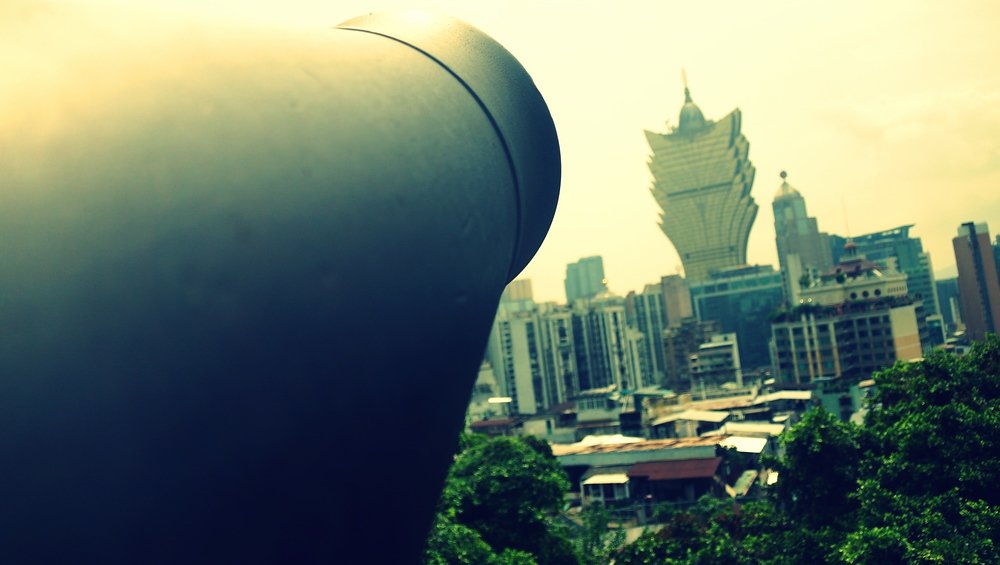
4) Mount Fortress
Finally we legged it up to Mount Fortress (Portuguese: Fortaleza do Monte; Chinese: 大炮台) for impressive 360 degree panoramic views of the city.
Fortaleza do Monte (Portuguese for Mount Fortress, also Monte Forte, officially Fortaleza de Nossa Senhora do Monte de São Paulo, in English: Fortress of Our Lady of the Mount of St. Paul; Chinese: 大炮台)
Cannons remain, some pointing directly at some of Macau’s most monumental casinos, including the Grand Lisboa.
Overall, our late morning and early afternoon excursion was a fascinating glimpse into Macau’s past with hints of modernity and riches flashing in all directions from the peak of Fortaleza do Monte.
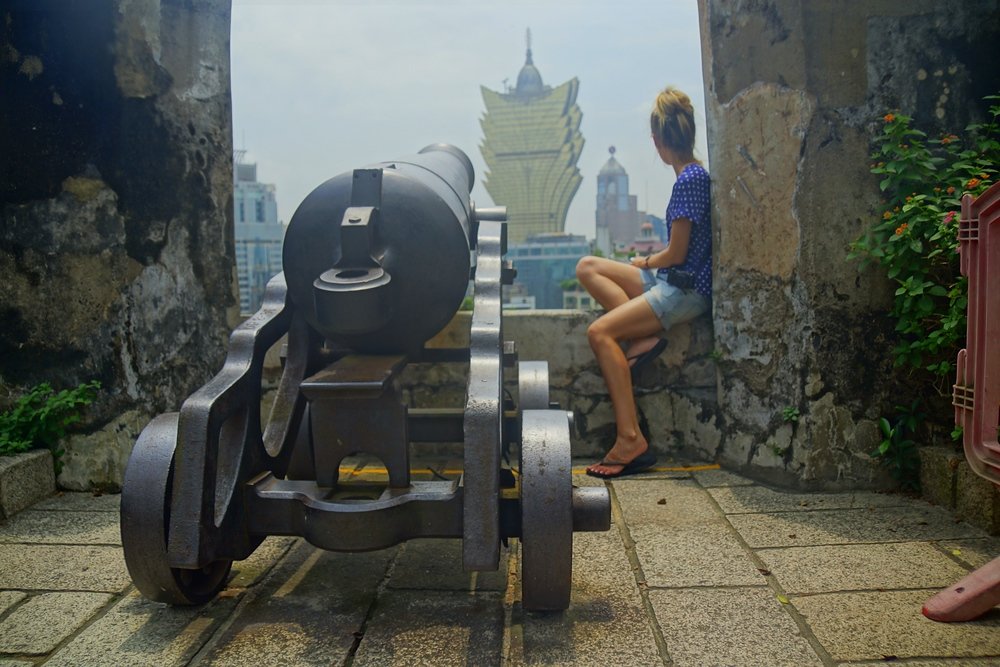
5) A-Ma Temple
A-Ma Temple stands as a profound symbol of the region’s spiritual and cultural heritage. Built in 1488, this ancient temple, dedicated to the sea goddess Mazu, is among the oldest in the area. Its architecture is a captivating blend of traditional Chinese elements and subtle Portuguese influences. The moment you pass through its grand, timeworn gates, you’re transported back in time. The temple’s intricate carvings, vibrant ceramic tiles, and ornate pavilions speak of an era where spirituality was intertwined with everyday life.
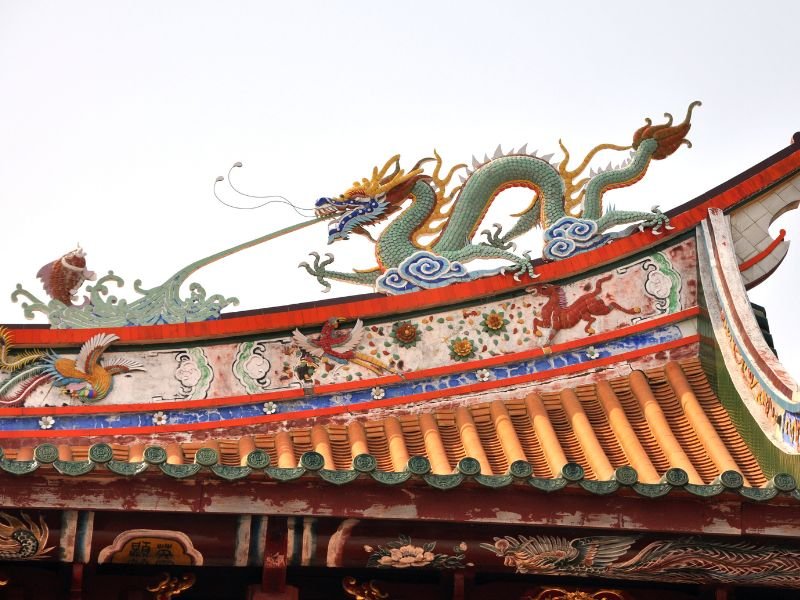
- Timeless Architecture: A-Ma Temple’s courtyards and shrines are adorned with elaborate woodwork, stone carvings, and statues that depict scenes from Chinese mythology. The Hall of Guanyin, with its intricate carvings and serene atmosphere, stands as a testament to the temple’s dedication to the goddess of mercy. The Pavilion of Benevolence, with its colorful, hand-painted tiles, showcases the artistic mastery of a bygone era.
- Cultural Significance: The temple is more than just a religious site; it’s a living museum that preserves the spiritual traditions and cultural practices of Macau’s past. Each element of the temple, from the dragon-adorned roofs to the incense-filled altars, tells a story of devotion and reverence that has been passed down through generations.
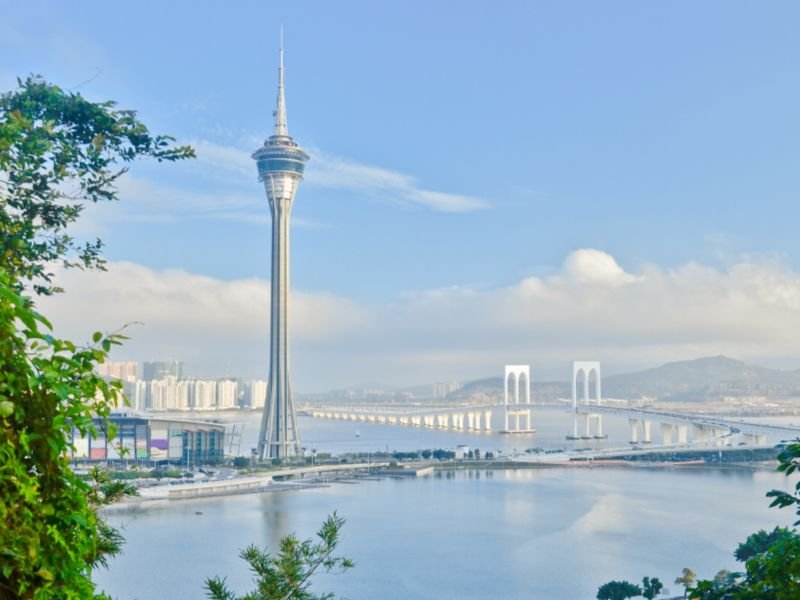
6) Macau Tower
Macau Tower is a towering figure on the city’s skyline. Standing at a staggering 338 meters, this architectural wonder offers visitors an experience like no other. The tower’s sleek design, combined with its impressive height, makes it a must-see for anyone visiting Macau. As you approach, the sheer scale of the structure is awe-inspiring.
- Engineering Feat: Completed in 2001, Macau Tower is a testament to cutting-edge engineering and architectural prowess. Its design was inspired by New Zealand’s Sky Tower, yet it has a character all its own, firmly rooted in the dynamic energy of Macau.
Unmatched Views
Once you ascend to the observation deck, you’re greeted with a panoramic view that is nothing short of spectacular. The 360-degree vistas allow you to see all of Macau, stretching out to the Pearl River Delta and beyond. On clear days, the views extend for miles, offering a stunning perspective of the city’s blend of historic charm and modern sophistication.
- Observation Deck: The main attraction is the observation deck, perched high above the city. With its floor-to-ceiling windows, visitors can enjoy unobstructed views that are especially breathtaking at sunrise or sunset.
- Glass Floor: For the more daring, sections of the deck feature a glass floor, allowing you to look straight down to the ground far below. It’s a thrilling experience that adds a touch of excitement to your visit.
7) The House of Dancing Water
Located in the City of Dreams complex in Macau, this breathtaking spectacle combines water, light, acrobatics, and dance in a way that’s nothing short of mesmerizing. Imagine a stage that transforms into a massive pool, with performers diving from dizzying heights, all choreographed to a beautiful score. It’s an immersive journey that leaves audiences spellbound.
- Impressive Scale: With a stage featuring a 3.7 million-gallon pool, the show’s scale is unmatched. The water element isn’t just a backdrop—it’s integral to the performance, with intricate fountains, splashing waves, and stunning underwater scenes.
- Innovative Technology: The production uses state-of-the-art technology to seamlessly blend live performance with special effects. From breathtaking light shows to mind-boggling stage transformations, the technical brilliance behind the scenes is as impressive as the performance itself.
So, what makes The House of Dancing Water such a unique experience? It’s the combination of cutting-edge technology, world-class performances, and a story that speaks to the heart. This isn’t just another show.
- A Visual Spectacle: Every aspect of the show is designed to dazzle, from the elaborate costumes to the state-of-the-art special effects. It’s a visual feast that offers something new to discover with every performance.
- A Universal Story: The House of Dancing Water tells a tale that’s both timeless and universal, making it accessible to audiences from all walks of life. It’s a story of love, courage, and the human spirit, all conveyed through the beauty of water and movement.
- An Unforgettable Experience: Whether you’re an art lover, a thrill-seeker, or just someone looking for an unforgettable night out, The House of Dancing Water delivers on all fronts. It’s a show that leaves a lasting impression, making it a must-see for anyone visiting Macau.
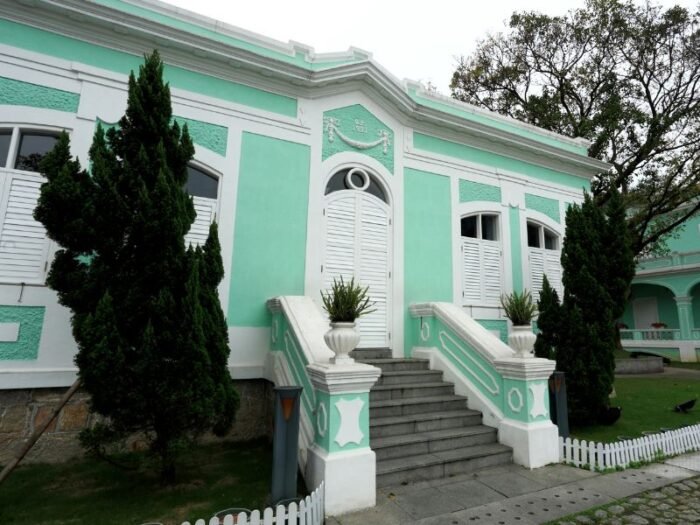
8) Taipa Village
Taipa Village is one of Macau’s best-kept secrets. Visiting offers a glimpse into the city’s past while blending seamlessly with its modern-day vibrancy. As you stroll through the narrow, cobblestone streets, you’re immediately struck by the contrast between old and new. Colorful colonial buildings line the streets, their pastel hues creating a postcard scene.
- Colonial Architecture: The village is a treasure trove of well-preserved colonial buildings. These structures, with their distinctive European style, stand as a reminder of Macau’s Portuguese past. They house everything from quaint cafés to boutique shops, each with its own unique charm.
- Traditional Temples: Interspersed among the colonial buildings are traditional Chinese temples, adding to the village’s eclectic charm. The Pak Tai Temple and Tin Hau Temple are both worth a visit. They offer a quiet respite from the bustling streets and a deeper connection to Macau’s spiritual roots.
- Street Food Delights: The village’s street vendors are a must-visit for anyone looking to experience authentic Macanese flavors. Try the famous Portuguese egg tart or a warm, freshly baked almond cookie—both are local favorites that you won’t want to miss.
- Diverse Dining Options: For those seeking a more formal dining experience, Taipa Village offers a range of restaurants that showcase the best of Macanese and international cuisine. Whether you’re in the mood for fresh seafood, traditional Portuguese dishes, or contemporary fusion, you’ll find it here.
- A Living Heritage: The village isn’t just a static monument to the past—it’s a living, breathing community where people live, work, and play. This dynamic atmosphere adds to the charm and allure of Taipa Village, making it a must-visit destination for anyone looking to experience the true spirit of Macau.
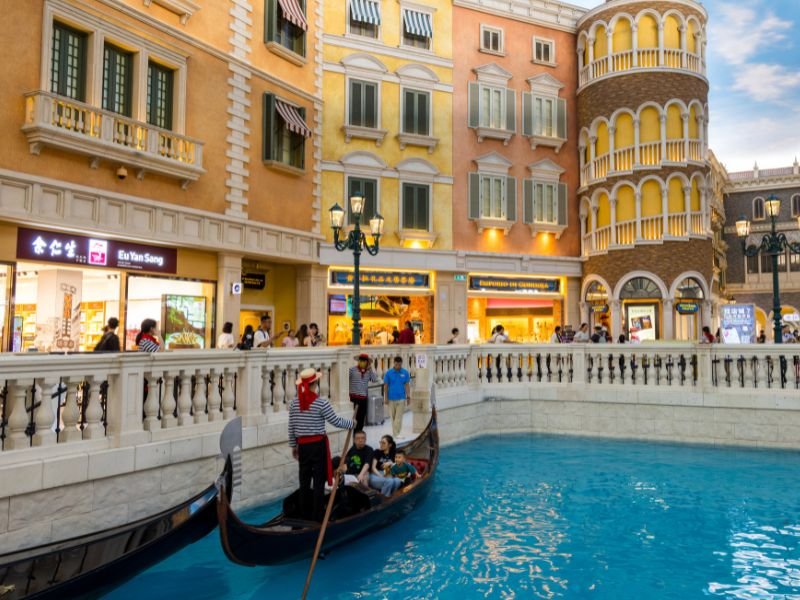
9) Venetian Macao
The Venetian Macao isn’t just a hotel and casino. It’s a sprawling, luxurious recreation of Venice, right in the heart of Macau. Imagine strolling through cobblestone streets, with gondolas gliding gently along canals beneath arched bridges.
- Iconic Canals: The highlight for many is the indoor canal system, complete with serenading gondoliers. It’s an experience that transports you straight to Venice, all without leaving Macau.
- Stunning Architecture: From the replica of St. Mark’s Square to the intricately designed facades of the buildings, the architecture of the Venetian Macao is a masterpiece.
- The Casino: Spanning over 550,000 square feet, the casino offers a vast array of gaming options. Whether you’re a seasoned gambler or just looking to try your luck, the variety and scale are unparalleled.
- Shopping and Dining: The Venetian Macao is also a shopper’s paradise. With over 350 shops, ranging from luxury brands to local boutiques, there’s something to suit every taste and budget.
- Live Shows and Events: Whether you’re interested in catching a big-name concert or watching an exciting sports match, the Venetian’s event calendar is packed with options.
10) Hac Sa Beach
Hac Sa Beach, located on the southern coast of Coloane Island, offers a unique escape from the bustling city life of Macau. What sets this beach apart is its striking black sand, a result of the natural minerals in the area. The name “Hac Sa” literally means “Black Sand,” and it’s this distinctive feature that draws visitors from near and far. The beach stretches over a kilometer. Thus, it provides ample space to relax, sunbathe, or take a leisurely stroll along the shore.
- Unusual Black Sand: The beach’s black sand is a rare sight in the region, making it a must-see for those interested in natural wonders. While some areas have been artificially filled with yellow sand to prevent erosion, the original black sand still dominates the landscape, giving Hac Sa its unique character.
- Natural Beauty: Surrounded by lush greenery and the gentle waves of the South China Sea, Hac Sa Beach is a peaceful haven for nature lovers. The contrast between the dark sand and the blue waters creates an experience that’s perfect for photography enthusiasts.
- Water Sports: The beach is popular with water sports enthusiasts, offering activities like windsurfing, jet skiing, and kayaking. The calm waters make it an ideal spot for both beginners and experienced adventurers.
- Picnic Spots and BBQ: For those who prefer a more laid-back experience, the beach has designated picnic areas and barbecue pits. It’s a great spot for families and friends to gather, cook up a meal, and enjoy the beautiful surroundings.
- Hac Sa Park: Just a short walk from the beach, Hac Sa Park is a great place to continue your day of fun. The park’s extensive facilities cater to all ages, from toddlers to adults, making it a popular spot for both locals and tourists.
11) Coloane Village
Coloane Village offers an escape from the fast-paced city life of Macau. Nestled on the southern coast of Coloane Island, this village is a window into the region’s past. With its narrow, winding streets and quaint, pastel-colored houses, Coloane Village feels like a step back in time. The village’s serene atmosphere, coupled with its well-preserved colonial architecture, offers visitors a taste of old Macau.
- Colonial Architecture: The village is dotted with colonial-style buildings, a reminder of Macau’s Portuguese heritage. These structures, with their colorful facades and traditional designs, add to the village’s nostalgic charm.
- Quiet Streets: Unlike the bustling streets of central Macau, Coloane Village offers a peaceful environment, perfect for a leisurely stroll. The quiet, cobblestone lanes are lined with small shops, cafés, and local businesses, each offering a unique slice of village life.
- Temples and Shrines: Coloane Village is also home to traditional Chinese temples, like the Tam Kung Temple, dedicated to the Taoist sea god. These spiritual sites add to the village’s cultural richness and provide insight into the local traditions.
- Lord Stow’s Bakery: No visit to Coloane Village is complete without stopping at Lord Stow’s Bakery, famous for its Portuguese egg tarts. These creamy, flaky pastries are a must-try and have earned a cult following among locals and tourists alike.
- Seafood and Local Cuisine: The village is dotted with small eateries offering fresh seafood and traditional Macanese dishes. Whether you’re enjoying a casual meal at a local café or dining by the waterfront, Coloane’s culinary scene is sure to satisfy.
12) Macao Museum
The Macao Museum offers a deep dive into the city’s cultural tapestry. It blends Portuguese and Chinese influences that define its unique character. Located in the iconic Monte Fort, the museum is a treasure trove of history and culture, spread across three floors.
- Historical Exhibits: The museum’s displays cover a wide range of topics, from the early days of Macau as a trading port to its development into a vibrant, multicultural city. You’ll find artifacts, maps, and documents that trace the city’s history, offering a detailed look at the events that shaped Macau.
- Cultural Artifacts: One of the highlights of the Macao Museum is its collection of cultural artifacts. These items, ranging from traditional Chinese art to Portuguese relics, showcase the blend of East and West that defines Macau.
- Hands-On Experiences: For those who like to get involved, the museum offers hands-on exhibits where you can try your hand at traditional crafts or explore historical artifacts up close. These interactive elements make the museum a hit with families and school groups.
- Monte Fort: The museum is housed within the historic Monte Fort, a 17th-century fortress that once protected the city from invaders. The fort itself is a fascinating historical site, and its elevated position provides breathtaking views of the surrounding area.
- City Views: From the fort’s walls, you can see the blend of historic and modern architecture that defines Macau. It’s a perfect spot to reflect on the city’s history and its dynamic future.

13) Guia Fortress
Perched atop Guia Hill, Guia Fortress is one of Macau’s most iconic landmarks. Built in the early 17th century, this historic site served as a defense against naval invasions. The fortress, with its whitewashed walls and simple yet commanding architecture, stands as a testament to Macau’s colonial past.
- Strategic Location: The fortress was strategically placed to offer a 360-degree view of Macau, allowing defenders to spot incoming threats from afar. Today, this vantage point provides visitors with breathtaking views of the city’s skyline, blending the old with the new.
- Well-Preserved History: Guia Fortress is part of a larger complex that includes the Guia Chapel and the Guia Lighthouse, Asia’s oldest Western-style lighthouse. Together, they form a historic site that offers a glimpse into Macau’s military past and colonial heritage.
- Guia Chapel: This small chapel is known for its beautiful frescoes, which depict scenes from both Western and Chinese religious traditions. It’s a quiet spot within the fortress, perfect for reflection and appreciation of Macau’s cultural fusion.
- Guia Lighthouse: The lighthouse, built in 1865, is a symbol of Macau’s maritime history. It’s still operational today, guiding ships safely to port. Climbing to the top offers a rewarding view of Macau and the surrounding waters.
- Fortifications and Exhibits: The fortress walls, cannons, and military artifacts provide a tangible connection to the past. Informative displays throughout the complex offer insights into Macau’s military history and the role Guia Fortress played in it.
14) Fisherman’s Wharf
Fisherman’s Wharf in Macau is more than just a waterfront—it’s a vibrant, themed entertainment complex. Spanning over 100,000 square meters, it’s designed to resemble various coastal cities around the world. As you walk through the different zones, you’ll feel like you’re traveling across continents, all within the same space.
- International Architecture: The Wharf’s design draws inspiration from cities like Amsterdam, Cape Town, and Venice. Each section features distinct architectural styles, from European-style streets to exotic, oriental-themed areas. The attention to detail in these recreations makes it a visually striking destination.
- A Blend of Cultures: The diverse architecture and themed areas create a multicultural experience, allowing visitors to immerse themselves in different cultures without leaving Macau.
- Amusement Park: The Wharf features an amusement park with rides and attractions for thrill-seekers and families. From roller coasters to carousels, there’s something for everyone to enjoy.
- Shopping and Dining: The complex is home to a variety of shops, from luxury boutiques to souvenir stalls, as well as numerous restaurants offering international cuisine. Whether you’re in the mood for fine dining or a casual meal, you’ll find plenty of options here.
- Roman Amphitheater: This stunning venue, modeled after the ancient Roman Colosseum, hosts a variety of live performances. Whether it’s a concert, a cultural show, or a seasonal festival, the amphitheater adds a touch of grandeur to any event.
15) Lotus Square
Lotus Square is home to the Golden Lotus Flower monument—a gift from the Chinese central government to mark Macau’s return to Chinese sovereignty in 1999. The sculpture, with its striking golden petals, stands 6 meters tall and is a symbol of prosperity. The square is a popular spot for both locals and tourists, offering a place of reflection and celebration.
- Symbolism: The blooming lotus, with its 16 gilded petals, symbolizes the everlasting prosperity of Macau under Chinese rule. The three layers of petals represent Macau’s three main regions: the Macau Peninsula, Taipa, and Coloane.
- Architectural Elegance: The golden hue of the lotus against the backdrop of the city’s modern skyline creates a captivating visual contrast. The monument’s location in the center of the square makes it a focal point for gatherings and cultural events.
- Cultural Significance: Lotus Square is more than just a picturesque location—it’s a place steeped in cultural significance. The monument serves as a reminder of Macau’s rich history and its ongoing journey as a Special Administrative Region of China.
- A Popular Gathering Spot: The square’s open space, coupled with the impressive monument, makes it a popular spot for both tourists and locals. It’s a place to take in the sights, snap a photo, or simply relax.
16) St. Lawrence’s Church
St. Lawrence’s Church, one of Macau’s oldest and most beautiful churches, is a stunning example of Baroque and neoclassical architecture. Built in the 16th century, this church has long been a spiritual cornerstone of the city. As you approach the church, its grand façade, adorned with intricate details and pastel hues, immediately draws your attention.
- Architectural Splendor: The church’s architecture is a harmonious blend of Baroque grandeur and neoclassical elegance. Its tall columns, ornate altars, and stained-glass windows create a serene atmosphere that invites reflection and reverence.
- Historical Significance: St. Lawrence’s Church has been a place of worship for centuries, making it a living monument to Macau’s religious heritage. The church was traditionally visited by families of Portuguese sailors, who prayed for the safe return of their loved ones.
- Peaceful Retreat: The church’s calm interior offers a respite from the hustle and bustle of the city. It’s a perfect spot for quiet reflection.
- Lush Surroundings: The church is surrounded by a beautiful garden, filled with tropical plants and shaded by old trees. The garden provides a peaceful setting for contemplation, with benches where you can sit and take in the serene environment.
- UNESCO Heritage: As part of Macau’s historic center, St. Lawrence’s Church is recognized as a UNESCO World Heritage site.

17) Kun Iam Statue
The Kun Iam Statue is one of Macau’s most striking landmarks. It stands tall at 20 meters on the waterfront near NAPE. This bronze statue depicts Kun Iam, the Buddhist goddess of mercy, known for her compassion and kindness.
- Stunning Location: Situated on a small artificial island, the statue overlooks the Pearl River, offering visitors a serene environment to reflect and admire the views. The location, with its open space and gentle breezes, adds to the statue’s calming presence.
- Architectural Beauty: The statue was designed by Portuguese architect Cristina Rocha Leiria, blending traditional Buddhist symbolism with contemporary design. The result is a monument that is both culturally significant and visually captivating.
- Ecumenical Centre: The center underneath the statue serves as a place for contemplation and education. It houses exhibitions that focus on the values of Kun Iam and the importance of compassion and peace in our lives.
- Cultural Significance: Kun Iam is a beloved figure in Chinese Buddhism, known for her boundless compassion and mercy. The statue is a reminder of these qualities, encouraging visitors to reflect on the importance of kindness and understanding in their own lives.
18) Macau Grand Prix Museum
The Macau Grand Prix Museum is a mecca for motorsport enthusiasts. This museum, dedicated to the history of the Macau Grand Prix, showcases the evolution of one of the world’s most challenging street races. With its impressive collection of race cars, motorcycles, and memorabilia, the museum has a lot to offer visitors.
- Historic Race Cars: The museum features an extensive collection of race cars that have competed in the Macau Grand Prix over the years. From vintage Formula 3 cars to cutting-edge motorcycles, each vehicle tells a story of speed, skill, and daring.
- Memorabilia and Exhibits: In addition to the vehicles, the museum houses a vast array of memorabilia, including trophies, helmets, and racing suits worn by legendary drivers. The exhibits provide a detailed look at the history of the Grand Prix, from its inception in 1954 to the present day.
- Racing Simulators: For those who want to feel the adrenaline rush of racing, the museum’s simulators offer a chance to virtually compete on the Macau Grand Prix circuit. It’s a thrilling experience that lets you test your skills and see if you have what it takes to handle the challenging course.
- Interactive Displays: The museum also features interactive displays that provide insight into the technology and engineering behind race cars. These exhibits are both educational and engaging, making them a hit with visitors of all ages.
19) Mandarin’s House
Mandarin’s House is one of Macau’s largest and most significant residential complexes. It offerings a glimpse into the life of a prominent Chinese family during the late Qing Dynasty. Built in the 19th century, this sprawling mansion was once home to the famous Chinese thinker Zheng Guanying.
- Architectural Splendor: The Mandarin’s House is a fine example of Chinese vernacular architecture, with its elaborate courtyards, wooden lattice windows, and intricately carved decorations. However, you’ll also notice Western elements, such as arched windows and European-style floor tiles, which add a unique flair to the design.
- Historical Significance: The house was the birthplace and residence of Zheng Guanying, a reformist thinker whose ideas influenced Chinese society in the late 19th and early 20th centuries. His works, including the famous “Words of Warning in Times of Prosperity,” were written here, making the house an important cultural site.
- Interior Spaces: The interiors of the house are beautifully preserved, with antique furniture, traditional decorations, and historical artifacts that give visitors a sense of the lifestyle of a wealthy Chinese family in the 19th century. Each room tells a story, from the elegant living quarters to the serene gardens where the family would gather.
- Courtyards and Gardens: The house is centered around several courtyards, which are peaceful, open spaces filled with greenery. These courtyards were designed to bring light and air into the house, creating a harmonious living environment that reflects the traditional Chinese values of balance and nature.
20) Camoes Garden and Grotto
Camoes Garden is one of Macau’s oldest and largest parks. It is dedicated to Luís de Camões, Portugal’s most celebrated poet. The garden’s centerpiece, the Grotto, holds a bust of Camões, making it a place of homage. As you stroll through the garden, you’re surrounded by lush greenery, winding paths, and peaceful spots to sit. The Grotto itself adds a sense of mystery and reverence to the experience.
- Historical Significance: The garden was once the grounds of a wealthy Portuguese merchant’s mansion, adding a layer of history to its natural beauty. The Grotto is said to be where Camões wrote parts of his epic poem “Os Lusíadas,” connecting visitors to a literary legacy that spans centuries.
- Winding Paths and Scenic Views: The garden’s design encourages exploration, with paths that meander through wooded areas and open spaces. Whether you’re walking, jogging, or simply taking in the views, the garden offers a refreshing retreat in the middle of the city.
- Lush Greenery: The garden is home to a variety of plant species, from towering trees to colorful flowers. The abundant greenery creates a calming environment, making it a perfect spot for a quiet stroll or a relaxing afternoon.
- Community Activities: The garden is a popular spot for community activities, from tai chi sessions to social gatherings. The lively atmosphere adds to the park’s charm, making it a great place to experience local culture and connect with Macau’s residents.
Planning Your Trip to Macau: Where to Stay, Eat & How to Fit It All In
Spending a day tracing cobblestones around Senado Square and climbing up to the Ruins of St. Paul’s is a great intro to Macau – but the city really comes alive when you start thinking about how you’ll base yourself, what you’ll eat beyond egg tarts, and how to stitch all the sights into an actual itinerary that feels fun instead of rushed.
Here’s how I’d plan a first (or second) trip to Macau if I were sitting down with you over a coffee and a pastel de nata.
Macau Neighbourhoods: Where You Actually Want To Sleep
Think of Macau as four main zones you’ll bounce between:
- Macau Peninsula – old town, UNESCO core, Ruins of St. Paul’s, Senado Square, many older casinos and local neighbourhoods.
- Taipa Village – atmospheric streets, food, low-rise pastel buildings, a bit more relaxed.
- Cotai Strip – the mega-resort strip with the Venetian, City of Dreams, Studio City and friends.
- Coloane – beaches, hiking, Coloane Village, Lord Stow’s, slower pace.
Quick Neighbourhood Snapshot
| Area | Vibe | Best For | Pros | Cons |
|---|---|---|---|---|
| Macau Peninsula | Historic, dense, chaotic in a good way | First-timers, history lovers, budget stays | Walkable to major sights, local food everywhere | Traffic, crowds, some older/tired accommodation |
| Taipa Village | Cute, foodie, semi-local | Couples, food-focused travellers | Great eats, character streets, close to Cotai | Limited budget stays, can feel busy on weekends |
| Cotai Strip | Shiny, air-conditioned, maximalist | Resort fans, families who want everything | Huge rooms, easy dining, indoor entertainment | Not very “local”, you’re in a bubble |
| Coloane | Sleepy, green, seaside | Repeat visitors, slow travellers, families | Quiet, nature, beaches, village charm | Fewer buses at night, limited nightlife & shopping |
If it’s your first time, I’d seriously consider:
- 2–3 nights on the Macau Peninsula if you want to lean into history and local life.
- 1–2 nights on Cotai if you want to experience the wild scale of the resorts, shows and shopping.
You can still day-trip easily to Taipa and Coloane from either base.
Where To Stay: Matching Area To Travel Style
Macau Peninsula – For History, Street Food & Short Walks
Staying on the Peninsula means you can roll out of bed and be in Senado Square, climb up to Fortaleza do Monte before the tour buses arrive, and sneak in a late-night bowl of noodles without getting in a taxi.
Good if you:
- Want to photograph streets when they’re quiet in the early morning.
- Prefer walking over shuttles.
- Are working with a mid-range or budget.
Look for places:
- Within walking distance of Senado Square / Ruins of St. Paul’s for classic sightseeing.
- Closer to the water if you’re taking the ferry and don’t want to wrangle bags for long.
Taipa Village – For Foodies And A Bit Of Atmosphere
Taipa is the sweet spot between local and resort. You can eat your way through hole-in-the-wall shops and then wander over to Cotai via the pedestrian bridges for casinos and shows.
Stay here if you:
- Care more about what you’re eating than how big the hotel lobby is.
- Like having nightlife options without being stuck inside a mall.
- Want to wander back alleys with your camera after dinner.
Cotai Strip – For “Macau As A Theme Park”
Cotai Strip is unapologetically over-the-top: massive malls, themed canals, endless buffets and shows like The House of Dancing Water. If you’re travelling with kids, grandparents, or anyone who likes everything under one roof, it’s incredibly convenient.
Stay here if you:
- You’re travelling with a group and want easy logistics—no one gets lost if almost everything is inside one complex.
- You plan to see multiple shows, hit the casino floors, or just soak up the spectacle.
- You want large, comfortable rooms and aren’t too worried about “authenticity” outside.
Coloane – For Quiet Mornings And Beach Walks
If you’ve already ticked off the major sights once, basing yourself in Coloane is a nice way to meet a calmer version of Macau. Think: morning walks along Hac Sa, lazy lunches, and coffee in Coloane Village.
Stay here if you:
- Are on a return trip and don’t feel the pressure to tick every box.
- Want a greener base and don’t mind riding buses or taxis to the more urban areas.
- Are happy trading nightlife for peaceful evenings.
Getting Around Macau
Macau looks small on the map, but zig-zagging between hills, bridges and one-way streets can eat into your day if you don’t plan your movements.
Walking
In Macau Peninsula, you’ll walk a lot—and that’s a good thing.
- Senado Square, Ruins of St. Paul’s, Monte Fortress, Macao Museum, St. Dominic’s Church and plenty of alleyways with food are all walkable in a compact loop.
- Expect stone surfaces and slopes; your legs will know they’ve been out.
Buses
Local buses are cheap and reach basically every area you’ll want as a visitor. A typical ride is only a few patacas. Wikipedia
- They connect the Peninsula with Taipa, Cotai and Coloane.
- Routes often stop near major sights like A-Ma Temple, Hac Sa Beach and Coloane Village.
- Have small change ready or a stored-value transport card if you’re staying a bit longer.
Casino & Hotel Shuttles
One of Macau’s best travel hacks:
- The big resorts on Cotai and around the ferry terminal run complimentary shuttle buses for guests and potential customers.
- They usually loop between the ferry terminal, some border points and different properties.
- Even if you’re not staying in a resort, you can often use the shuttles as a convenient way to move between areas, then walk or grab a short taxi ride from there.
Taxis & Ride Options
Taxis are reasonably priced for short hops, but traffic near the border and Cotai can be slow at peak times.
- Keep your hotel name and destination written in Chinese—many drivers are more comfortable with that than English.
- At night or with luggage, it’s worth the fare versus navigating buses.
Money & Daily Costs
Macau’s official currency is the Macanese pataca (MOP), but Hong Kong dollars (HKD) are widely accepted in shops, restaurants and casinos, and even withdrawn from many ATMs.
Rough, backpacker-style daily budgets (per person, excluding gambling):
| Travel Style | Approx Daily Spend (MOP/HKD combined) | What That Looks Like |
|---|---|---|
| Budget | 350–550 | Local eateries, buses, simple guesthouse/hostel, free sights and lots of walking |
| Mid-Range | 700–1,200 | Comfortable hotel, mix of local and mid-range restaurants, a show or paid attraction |
| High-End (non-casino) | 1,500+ | Resort stay, fine dining, multiple paid attractions and activities |
Tips:
- Many prices are listed in MOP, but paying with HKD is normal—just keep an eye on the exchange rate and how change is given.
- Street food and simple local places are much cheaper than eating inside the integrated resorts.
- If you gamble, mentally treat that as a separate “entertainment” budget so it doesn’t swallow everything else.
What To Eat (Beyond Egg Tarts)
Yes, you should absolutely track down a still-warm Portuguese egg tart. But Macau is one of those destinations where eating well is half the trip.
Classic Macanese & Portuguese Flavours
Look for:
- African chicken – grilled chicken in a rich, spiced sauce.
- Minchi – minced meat with potatoes and a fried egg, comforting and slightly addictive.
- Pork chop buns – crispy, juicy and perfect as a snack between sights.
- Seafood rice or seafood stews – Portuguese-influenced dishes that feel like Macau in a bowl.
Where To Focus Your Food Hunting
- Macau Peninsula backstreets for small, no-frills spots the locals actually use.
- Taipa Village for a mix of snack stalls, egg tart legends, tiny cafes and atmospheric restaurants.
- Coloane Village for long, lazy lunches, especially if you’re pairing it with a beach walk.
If you only have one night, I’d personally eat in Taipa Village: wander, snack, then sit down somewhere busy and noisy enough that you know the food is turning over fast.
Sample Itineraries For Macau
You can treat Macau as a day trip from Hong Kong, but if you give it a couple of nights it stops being a checklist and starts feeling like a real place.
One Day “Essential Macau” (First-Time Hit List)
Good if you’re arriving early and leaving late or staying just one night.
Morning – Old Macau Walk
- Start in Senado Square before the crowds build.
- Walk up to St. Dominic’s Church, then continue to the Ruins of St. Paul’s and Monte Fortress.
- Duck into small alleys for street snacks as you go.
Lunch
- Eat near the old quarter: pork chop buns, noodles, or a simple set lunch in a local café.
Afternoon – A-Ma & The Water
- Head to A-Ma Temple, lingering long enough to soak up the incense and hillside views.
- If you still have energy, wander the waterfront or pop into the Macao Museum if you skipped it earlier.
Evening – Cotai Lights
- Shift over to Cotai Strip in the late afternoon.
- Ride a gondola at the Venetian, browse the over-the-top shops, and have dinner in one of the resort restaurants.
- If you’ve got tickets, end the night with The House of Dancing Water or another big show.
Two Days – Culture, Food & A Little Resort Time
Day 1 – Peninsula + Cotai (as above)
Day 2 – Taipa & Coloane
Morning in Taipa Village:
- Wander the lanes, visit a temple or two, and graze on egg tarts and street food.
- Check out the Taipa Houses Museum area for a quieter stretch of waterfront and pastel buildings.
Afternoon in Coloane:
- Continue on to Coloane Village, exploring its church, waterfront and narrow lanes.
- Walk or bus over to Hac Sa Beach if you want sea air and a stroll along the black-ish sand.
- Late afternoon coffee and pastry before heading back.
Evening:
- Back to Taipa or Cotai for dinner, depending on where you’re staying. If you’re on the Peninsula, this is a good time for another round of night photography around the old streets.
Three Days – Deep Dive & Slower Pace
With a third day, you can:
- Spend half a day at Guia Fortress and Lighthouse, then wander lesser-known parks and neighbourhoods on the Peninsula.
- Dig into museums like the Macao Museum, the Maritime Museum or the Grand Prix Museum if you’re a motorsport fan.
- Schedule a long, lingering lunch in Coloane or Taipa instead of rushing back and forth.
The key is to use each day to focus loosely on a couple of areas rather than pinballing between all four zones.
Practical Tips & Common Mistakes To Avoid
1. Underestimating How Tired You’ll Be Indoors
Macau’s resorts are like self-contained cities. Walking the length of a mall, then through another wing, then over a bridge to another complex can be just as tiring as a day outside. Build in actual breaks—coffee stops, sitting by a window, or just going back to your room for an hour.
2. Treating It Only As “Mini Vegas”
If you never leave the Cotai Strip, you miss all the layers that make Macau interesting: old shop houses, tiny shrines squeezed between buildings, locals doing their shopping, and that weird mix of European facades with Chinese signboards.
Try to:
- Give at least one full daylight block to the historic centre.
- Spend at least one mealtime in Taipa or Coloane away from the casino floors.
3. Not Planning Around Weekends & Chinese Holidays
Weekends and major holidays can mean:
- Bigger crowds at the main photo spots.
- Higher room rates on Cotai, especially if there’s a big event.
- Longer lines at immigration and on popular routes.
If your schedule is flexible, aim your big-sight days for weekdays and use busier periods for slower wandering, cafe-hopping, or hotel pool time.
4. Ignoring The Heat & Humidity
Macau can feel like a steam room, especially in summer.
Practical things that help:
- Start outdoor sightseeing early, retreat indoors during the fiercest heat, then go back out late afternoon.
- Carry water and something salty to snack on.
- Pace yourself if you’re climbing up to forts and viewpoints.
5. Moving Hotels Too Often
Switching once—from Peninsula or Taipa to Cotai, or vice versa—can make sense. But if you only have two or three nights, hopping around more than that eats into your actual travel time. Better to pick a smart base and day-trip.
A Simple “Game Plan” For A First Trip
If you like having a rough blueprint, here’s a straightforward approach you can adapt:
| Trip Length | Where To Stay | Main Focus Each Day |
|---|---|---|
| 1 night | Peninsula or Cotai | Old town + one big resort experience |
| 2 nights | 1 night Peninsula, 1 night Cotai | Day 1: Historic centre, A-Ma, Ruins; Day 2: Taipa/Coloane + Cotai show |
| 3 nights | Peninsula or Taipa + Cotai last night | One full day for Peninsula, one for Taipa/Coloane, one mixed/free day |
From there, you can dial it up or down depending on how much you like food missions, how curious you are about temples and forts, and how tempted you are by the glowing casino floors.
However you shape it, if you balance Macau’s quieter corners with its loudest, flashiest ones, you come away with a much more interesting story than “I went to the casinos for a day.”
Macau Travel Questions & Answers: Local-Style Tips, Logistics & First-Time Planning Advice
How many days do I really need in Macau to see the main attractions?
Honestly, two full days is the sweet spot for most travellers. With that, you can cover the historic core around Senado Square and the Ruins of St Paul’s, head up to forts and museums, then still have time for Taipa, Coloane and at least one big Cotai resort experience without rushing every step.
If you only have a single day, focus on the peninsula in daylight and then hop over to Cotai at night for the wow factor. If you can stretch to three days, Macau slows down nicely: you can linger in Coloane, spend longer in museums, catch a show, and enjoy more meals that are not just grabbed on the go between sights.
Is Macau still worth more than a day trip from Hong Kong?
Yes. A day trip is fine if you just want a quick taste, but staying overnight completely changes the feel of the place. Early mornings around Senado Square, quiet side streets, and night photography around the old town are things most day trippers never see.
An overnight stay also means you are not burning energy commuting both ways on the same day. You can do the historic centre at your own pace, enjoy a proper dinner in Taipa or Coloane, take in a show or gondola ride on Cotai, and still have time to just wander without clutching a timetable.
When is the best time of year to visit Macau for sightseeing and nicer weather?
Generally, the most comfortable months are from about October to December, when the weather is cooler, less humid and skies are often clearer. Spring, especially March and April, can also be pleasant, though it sometimes comes with fog and drizzle.
Summer, roughly June to September, is hot, humid and can be very wet, with tropical downpours and the risk of typhoons. Winter is usually mild rather than freezing, but it can feel damp and chilly indoors because buildings are not always well heated, so a light jacket still helps. If you are planning a first trip, aim for autumn or late spring if you can.
Which area should I stay in for my first trip to Macau?
It depends. If you want historic streets, easy access to UNESCO sites and lots of local eats, the Macau Peninsula makes the most sense. You can walk to many of the classic sights, grab cheap and tasty meals, and feel like you are in a real city rather than just inside a resort.
If you prefer a more resort-style stay with everything under one roof, Cotai is ideal. Families and groups often love it because you can shop, eat, swim and see shows without ever stepping outside. Taipa Village is a nice in-between option with atmosphere and food, while Coloane is perfect if you are on a repeat visit and want quieter mornings, beaches and greenery.
How do I get from Hong Kong to Macau and back?
Easily. High-speed ferries and buses across the Hong Kong–Zhuhai–Macau Bridge are the two main options most visitors use. Ferries connect Hong Kong with terminals on the Macau Peninsula and Taipa, and they are comfortable and straightforward as long as you keep an eye on the latest schedules.
The bridge buses are handy if you are coming from areas closer to Hong Kong International Airport or the western side of the New Territories. Travel times are broadly similar once you factor in border formalities, so I usually suggest picking the option that lines up best with where you are starting and where your hotel is. Always double-check current timetables and departure points, as these can shift over time.
Do I need a visa to visit Macau as a tourist?
Usually not for a short trip, but it depends entirely on your passport. Many nationalities, including travellers from places like the United States and much of Europe, can enter Macau visa free for a limited stay, often around 30 days for tourism.
However, the rules are different for each country and can change. Before you travel, check the latest entry requirements from an official source such as your government’s travel advice site or Macau’s immigration information. If you are combining Macau with Hong Kong and mainland China on the same trip, remember that each has separate immigration rules, so you need to make sure your plans fit all three sets of requirements.
How safe is Macau, and what scams should I watch out for?
Generally, Macau is considered a safe city for travellers, with lower levels of violent crime than many big cities. The main things to watch out for are the usual urban issues: pickpocketing in crowded areas, especially around major tourist sights and busy shopping streets, plus the odd pushy tout or overcharging taxi.
As in any casino destination, be extra careful if strangers approach you with gambling schemes, currency exchanges away from official counters or offers that seem far too generous. Keep drinks in sight, use ATMs attached to banks or inside reputable buildings, and make sure taxis use the meter or agree on a clear fare before you get in. Basic street sense goes a long way here.
Is Macau a good destination for families and kids, or is it mainly for gamblers?
Absolutely. If you only walk through casino floors, it can feel like the city is built purely for gamblers, but there is a lot for families once you look beyond the gaming tables. Resorts on Cotai have big rooms, pools, themed shopping areas and kid friendly entertainment, while Fisherman’s Wharf, parks and beaches like Hac Sa give you space to run around.
On the cultural side, children often enjoy climbing up to forts, exploring museums with ships and racing cars, and trying new snacks in Taipa or Coloane. The trick is to balance indoor resort time with outdoor exploring, and to pick hotels that clearly welcome families rather than ones that are geared only towards high rollers.
How expensive is Macau, and what kind of daily budget should I plan for?
Macau can be as affordable or as pricey as you let it be. Eat in local cafes and noodle shops, ride buses and stay in simpler guesthouses on the Peninsula, and you can get by on a modest daily budget. Once you start staying in big name resorts, booking shows and dining inside malls, your costs jump quickly.
As a rough backpacker style guideline, you might manage on a few hundred patacas per day if you are careful; mid range travellers who want comfortable hotels, some paid attractions and nicer meals should expect to spend more. The big variable is gambling, so it is smart to treat that as a separate entertainment budget rather than letting it quietly swallow everything else.
What is the easiest way to get around Macau once I am there?
Walking is still the best way to explore the historic core on the Peninsula, even if your legs complain about the hills and cobblestones. For longer hops, the local bus network is cheap and covers the peninsula, Taipa, Cotai and Coloane, with typical fares only a handful of patacas whether you pay in cash or use a stored value card.
Locals commonly use the Macau Pass card, which works on buses and other services and is now part of the wider China T Union system. Casino and hotel shuttles can be handy for moving between Cotai, ferry terminals and some border points, while taxis are useful late at night or when you do not want to wrestle luggage onto a bus. I normally mix walking, buses and the occasional shuttle or taxi depending on the day.
Can I explore Macau without ever stepping into a casino?
Yes. You could easily spend several days in Macau and barely see a slot machine. The historic centre, temples, forts, museums, Taipa Village, Coloane’s beaches, Hac Sa Park, gardens and waterfront promenades can fill a full itinerary if culture, food and photography are your main reasons for visiting.
You might still end up walking through resort complexes to catch a shuttle, watch a show or eat in a restaurant, but you do not have to gamble to enjoy those parts. If you prefer to avoid casino floors entirely, base yourself on the Peninsula, in Taipa Village or Coloane and treat the Cotai Strip as an optional side trip rather than the centre of your stay.
What is the weather really like in Macau, and what should I pack?
Humid. Even when temperatures are not sky high, the air can feel heavy, especially from late spring through early autumn. In summer, daytime highs are hot, humidity is intense and sudden downpours are common, so light, breathable clothing, a hat, sunscreen and a small umbrella are your best friends.
In winter, temperatures are milder but it can still feel chilly indoors because heating is not always strong. A light jumper or jacket, long trousers and something you can layer are useful then. Comfortable walking shoes with some grip are essential year round because many streets are paved in stone and can get slick in the rain.
How does typhoon season affect travel plans in Macau?
Typhoon season typically falls between about June and September, overlapping with the steamy summer months. During this time, you can get very heavy rain, strong winds and occasional disruptions to ferries, flights and bridge buses when a storm is close enough to trigger warnings.
If you are visiting then, build some flexibility into your plans. Avoid stacking every big sight into a single day, keep an eye on local weather alerts, and be prepared to swap in indoor activities or resort time at short notice. Travel insurance that covers weather related delays is a smart idea for this time of year.
Is Macau easy to visit with limited mobility or if I do not like lots of stairs?
Not really, but it is manageable with planning. The old streets on the Peninsula were not designed with wheelchairs in mind, and there are plenty of slopes, stairs and uneven pavements. Reaching places like the Ruins of St Paul’s or some fort viewpoints can involve climbing.
However, modern areas such as Cotai, many big hotels and the newer transport hubs tend to have lifts, escalators and wider corridors, so basing yourself there can make life much easier. If mobility is a concern, choose accommodation that clearly advertises accessible rooms, plan more time for moving between areas, and do not be shy about using taxis instead of long uphill walks.
Can I use Hong Kong dollars, Octopus or contactless payments easily in Macau?
Mostly. The official currency is the Macanese pataca, but Hong Kong dollars are widely accepted in shops, restaurants and casinos, and many ATMs in Macau dispense Hong Kong dollars as well as patacas. In day to day use, you can often pay in Hong Kong dollars and receive change in a mix of currencies, so it is worth keeping an eye on your wallet.
For transport and small purchases, locals use the Macau Pass and other contactless cards tied into the China T Union network, and many shops support bank cards and mobile wallets. A standard Hong Kong Octopus card is not universally accepted everywhere in Macau, though newer cross border versions linked to the China T Union system are becoming more useful, so I would treat that as a nice bonus rather than your main payment plan. A mix of cash, one or two major cards and a local or regional transport card covers most situations.

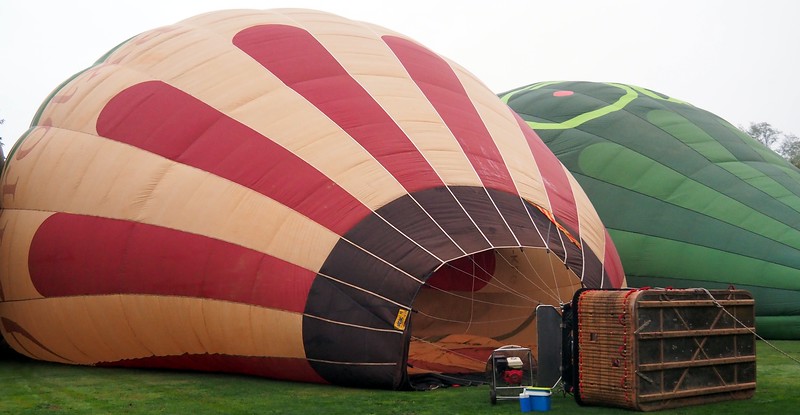

We visited Macau at Christmas, thinking that it wouldn’t be crowded since the Chinese don’t celebrate the holiday. We couldn’t have been more wrong! It was probably the most crowded place I’ve ever seen, and I lived in Shanghai for two years! There were so many people that it was actually wasn’t enjoyable to walk around. I’d love to go back and experience the old architecture at a different time of year.
That’s too bad Heather!
I probably would have assumed the same thing as you. Macau is a really small city, so a surplus of tourists would be really hard to accommodate.
Would love to visit Macau! great photos and video guys!
Thanks for sharing Macau with us! Glad I got to read this – sounds like an interesting place!
Thanks Renuka! It is a very interesting place 🙂
Love the cobblestones, the lanterns, the vistas and the pearl tea… careful with those, they are soooo filling, so split if you’re also eating a meal.
Great first impressions too.
Btw, stay hydrated – I live in high heat/humidity and you can dehydrate quickly in that weather without realizing it until you’re sick.
Thanks Maria!
We’ve had issues with staying hydrated at times. I think we need to carry more water with us as we roam around.
Those pearl teas are awfully filling! I was wondering why my pants felt a little tight afterwards 😉
Sam, this is completely selfish advice… Drink more water! I want, no that’s not true, I NEED more updates from you and Audrey. Yes I’m Addicted to the dynamic duo. Admission is the first step
Awesome pics! I LOVED Macau!!!!
Thanks Andi! It’s a great place to spend a few days 🙂